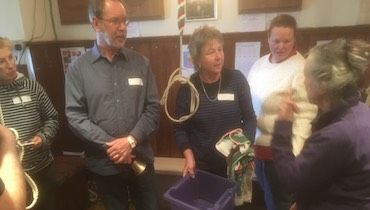M2F: 6 April 2019 - Shirenewton
In from the chilly April morning came a procession of trainee teachers, mentors and even a couple of ART assessors. The church room was warm and there was tea in the pot. Pip Penny made sure we felt welcome.
The course was originally scheduled for Newnham in Gloucestershire, using the newly restored bells there, but as I write the bells are still not back from the Nicholson’s workshop in Bridport. So many thanks to Pip for volunteering the use of St Thomas a Becket’s six bell tower.
After an early powerpoint session recapping the key skills of bell ringing we decamped to the cosy ringing room above the chancel. Pip took us through a range of exercises designed to consolidate bell control, listening and rhythm. The aim was to use all these skills in order to ring in perfect rounds. For example, we rang rounds with 2 and 4 pulling off from backstroke. This made everyone listen harder and it was also good practice for leading. Another challenge was to keep the rhythm of rounds while each of us took a turn to face the wall. We used a spinner to decide which ringer would face the wall next.
Pip had us all chanting in the rhythm of rounds.“We all like fish and chips we want some for our tea sniff”. The sniff is the pause of the open hand stroke lead. On 8 bells you could add “right now!”. With a large group of novice learners some can be practicing this rhythm on hand bells in the church while others are being taught on the ropes.
Our next theory session was about ways to keep learners motivated. The challenge, as Pip often remarks, is to make learning fun. Another recommendation is that we should try to provide learners with a sense of achievement every time they come.
Lunch was taken at a local hostelry after which we moved on to call changes. Our challenge was to explain in five minutes what is involved in ringing changes, both the theory and the practice. Needless to say we gave Pip plenty of scope to suggest improvements. Back in the tower we were shown how to keep track of our place and be ready for the next call. Each of us were invited to recite the 5 key facts about our place in the sequence. Take the example of bell 5, called down from rounds to follow bell 3.
“I am the bell 5, in 4th place, following bell 3, which is following bell 2 and bell 4 is following me”. As a hopeless change ringer I am very pleased to have learned this technique.
The final part of the day was spent working on ways to help learners practice moving one place up or down – with corresponding adjustments on the rope.We tried out techniques such as Mexican Wave and Bastow Doubles. Kaleidoscope made a great impression. This is where pairs of bells are asked to ring either long places, or regular places, or to dodge; bells stay within their pair and their work reflects the level of skill they have reached. So on six bells you could have 4 and 5 making long places and 1 and 2 making regular places. Even the bells not moving are gaining skills, in this case 3 and 6 are covering the pair in front. My mentor, John Simms and I, were inspired by the flexibility of Kaleidoscope and John has already been using it with learners at his tower.
A full day led by a challenging teacher, good value for money at £20 and I came away with two new books to add to my bank of teaching ideas. Thank you, Pip.
Andy Vivian

Course Tutor: Pip Penney

Teaching from Rounds to Plain Hunt
Learn how to teach build really good foundation ringing skills in your ringers.